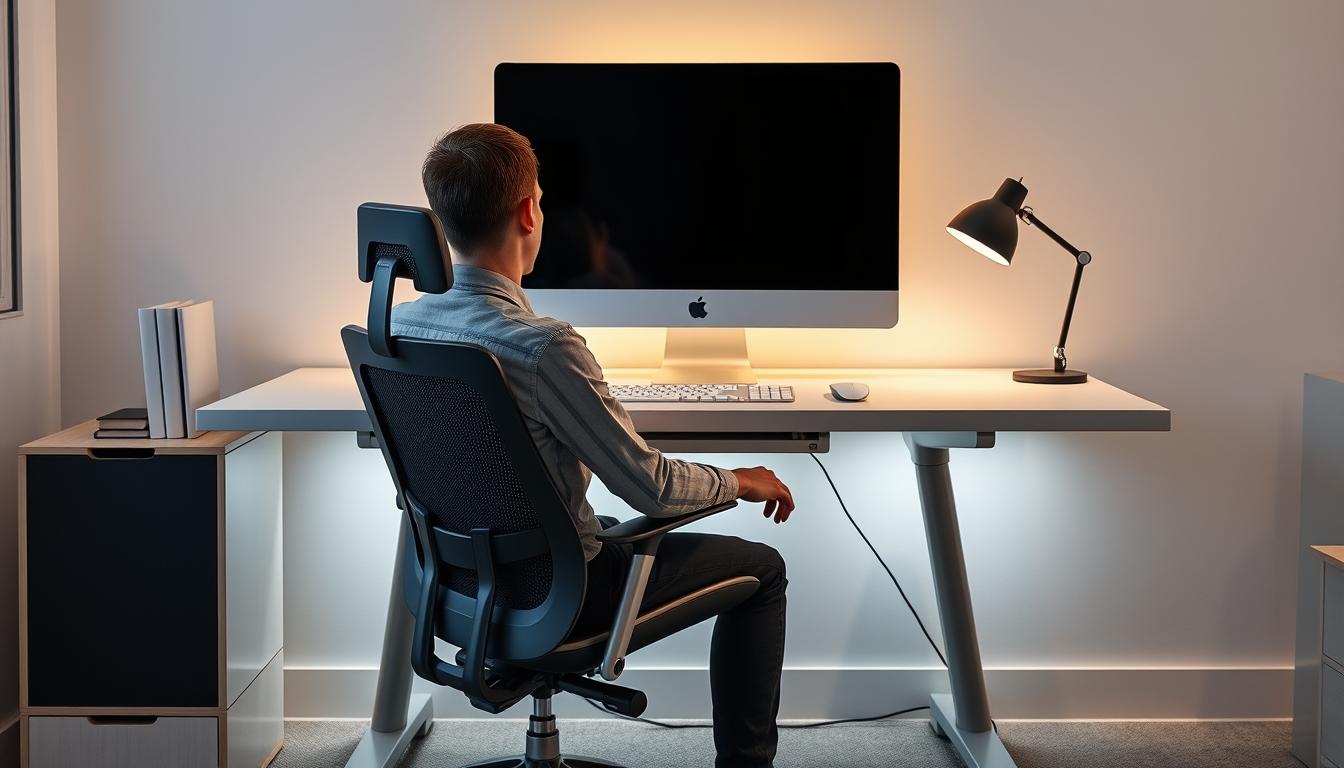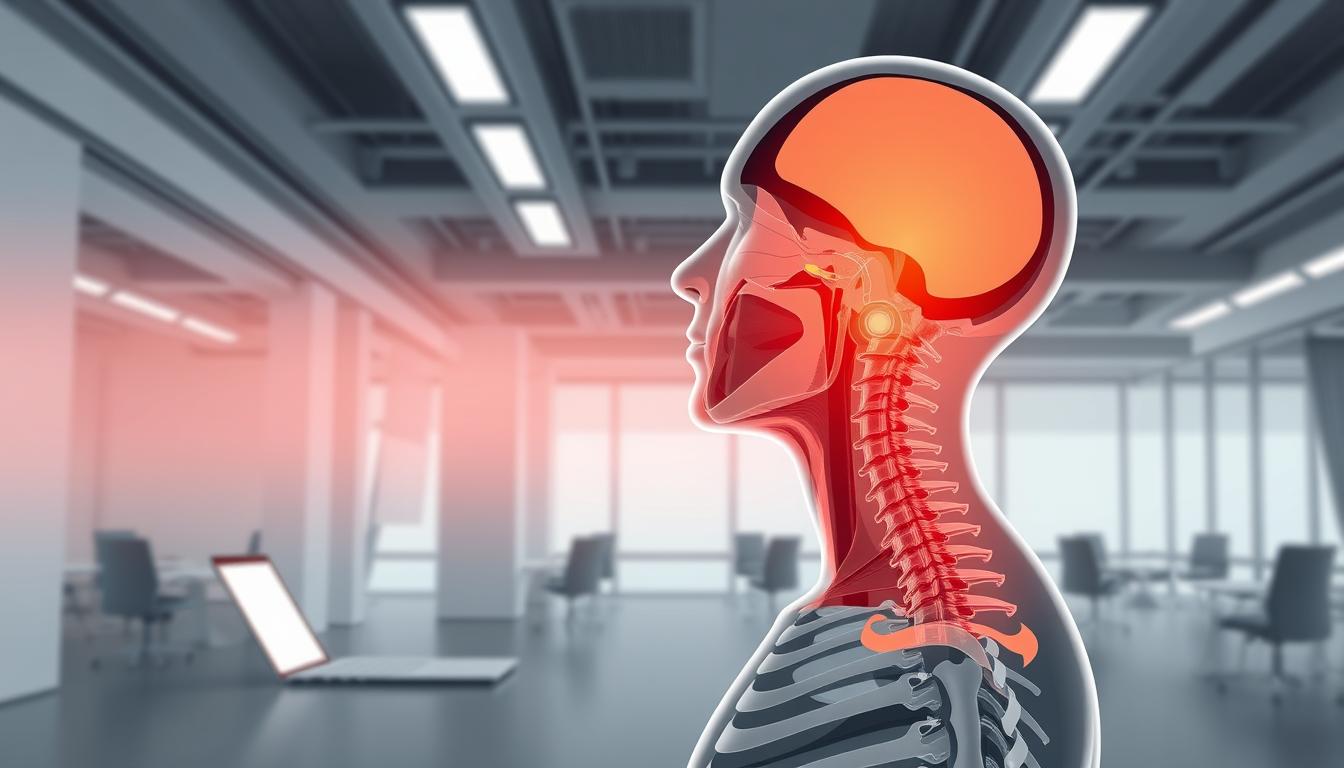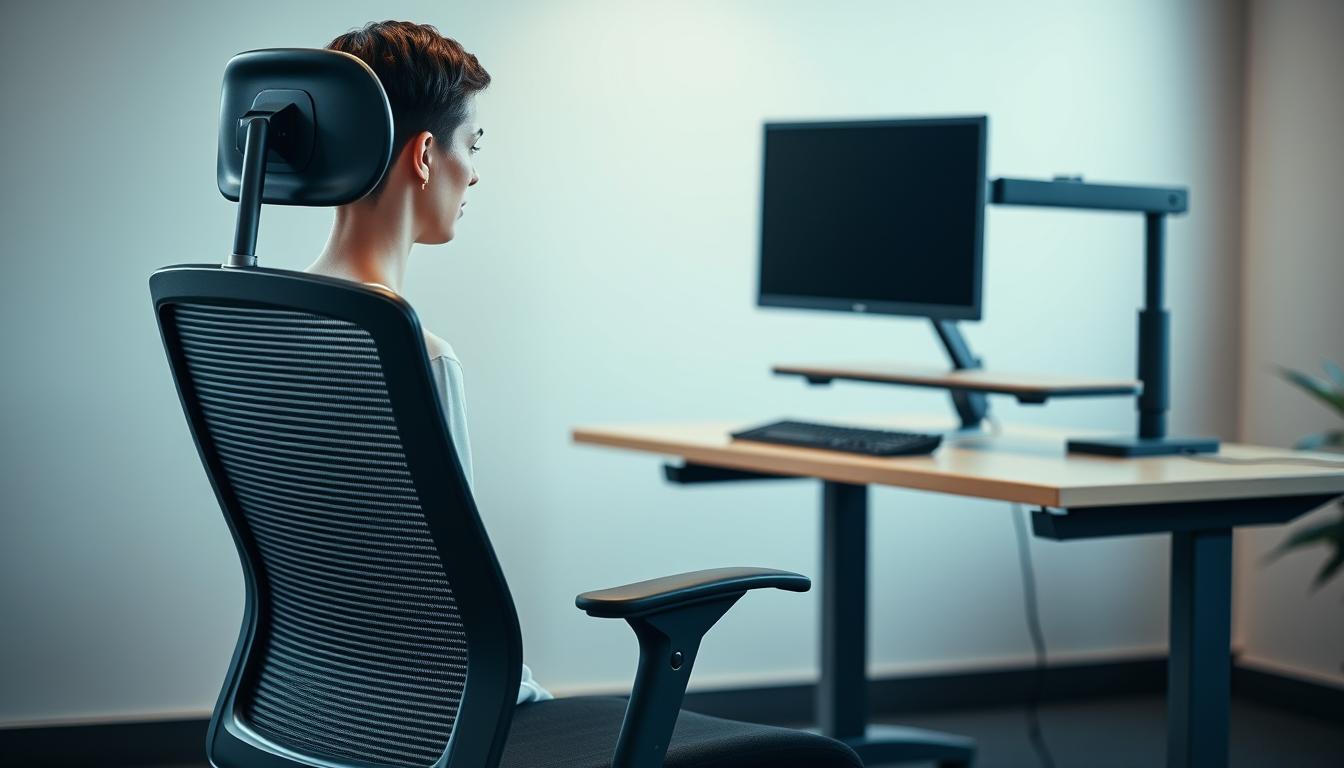It’s important to have a good desk setup to stop neck pain, especially if you work at a desk a lot. This guide will help you make your workspace better by using office ergonomics. We’ll use advice from the Mayo Clinic and OSHA to show you how to work comfortably. This way, you can avoid neck pain and be more productive.
Understanding Ergonomics and Neck Pain
Understanding how to tackle neck pain starts with grasping what ergonomics means. It’s about creating work setups that meet the needs of each person. By focusing on making workers more comfortable and reducing strain, particularly for those in office settings for long hours, we can prevent pain. Learning about the ergonomics for office workers is vital to avoid discomfort and lessen neck pain problems.
Definition of Ergonomics
Ergonomics is the science that focuses on making jobs, workplaces, and tools fit better with the workers’ physical and mental abilities. This effort aims at making workspaces more efficient and safe. It’s all about preventing injuries and making work comfortable.
Common Causes of Neck Pain in Office Workers
Office workers face neck pain causes that are quite common. These include:
- Prolonged sitting without breaks
- Poor posture from not adjusting chair and desk correctly
- Repetitive strain from too much computer or device use
- Not having enough support for the neck and back
Improving workspaces according to ergonomic principles can cut down on these discomforts. It helps in creating a healthier work environment.
The Impact of Poor Posture on Neck Health
Poor posture can really hurt your neck, with tech neck becoming a big problem for many. This issue often comes from how we tilt our heads forward when using gadgets. If you don’t sit right for a long time, it can make your neck muscles tired and sore. Getting why poor posture is bad helps us stop more neck problems.
How Poor Posture Leads to Tech Neck
Tech neck shows the bad effects of leaning your head forward. This wrong position makes your neck and back muscles work too hard. If you keep doing this, you might end up with lasting pain and tightness. Catching this early can prevent worse problems.
Signs of Poor Posture
Knowing the signs of bad posture can spur you to act. You might notice:
- Rounded shoulders
- Forward head position
- Increased muscle tension in the neck and upper back
Spotting these hints lets you start fixing your posture. Making your workstation better can ease your neck’s burden.
Choosing the Right Office Chair
Picking the right office chair is key for staying comfy and avoiding neck pain during long workdays. A good chair offers proper lumbar support, keeping the spine’s natural curve. This reduces back and neck strain, helping you work better and longer.
Importance of Lumbar Support
Lumbar support is key for good posture. Without it, you’re more likely to get back pain. Chairs with adjustable lumbar support mold to your back. This gives your lower spine top support, boosting your posture and comfort. It makes you more productive, too.
Adjustable Features to Look For
Look for office chairs with adjustable features. Being able to change the height, armrests, and seat depth means you can customize your chair. Adjustable armrests should be close to your body and at a height where your arms can rest easily. This lessens neck and shoulder strain. Chairs that tilt and move easily work for various body types and seating preferences.
Desk Height and Positioning
Finding the right height for your desk is key to a comfortable work area. The height affects your comfort and how well you work. A desk that matches your body’s needs lessens strain during long work hours.
The Importance of Desk Height
Having your desk at the right height keeps your forearms level when you type. This reduces neck and shoulder pressure, lowering the risk of pain. If your desk doesn’t adjust, using strong blocks can make it taller. This is vital for both comfort and staying pain-free all day.
How to Adjust Your Desk for Comfort
Checking your workspace setup can make sitting more comfortable. Follow these steps to find the best desk height:
- Sit in your chair with your feet flat on the floor.
- Make sure your elbows form a 90-degree angle when typing.
- Change the desk height so your arms are straight out in front of you.
- Make sure your computer monitor is at eye level to avoid strain.
By making these changes, you’ll improve your desk’s ergonomics. This means less strain and more comfort when working.
Best Desk Setup to Prevent Neck Pain
Setting up an ergonomic desk is key to avoiding neck pain. A well-designed workspace brings comfort and lowers strain on the body. By placing monitors, keyboards, and phones correctly, you help your body move less. This eases potential discomfort. The setup of your workspace greatly affects your health.
Layout Essentials for an Ergonomic Workspace
To create the best desk layout, remember these points:
- Position your monitor at eye level to avoid tilting your head.
- Ensure your keyboard and mouse are set at a comfortable height to keep your wrists straight.
- Keep frequently used items within arm’s reach to limit stretching and reaching.
- Designate specific areas for documents and accessories to maintain organization.
Key Accessories to Enhance Your Setup
Adding accessories can make your desk setup more ergonomic and comfy. Consider adding these:
- Monitor risers to align your screen with eye level.
- Keyboard trays that promote a neutral wrist position.
- Footrests to ensure proper leg positioning and support.
- Document holders to keep paperwork at eye level.
Monitor Placement for Neck Protection
Having your monitor in the right spot is key to keeping your neck in good shape. By setting up your screen ergonomically, you avoid straining your neck. This setup makes you more comfortable and helps you work better.
Correct Height for Your Monitor
Your screen’s top should be at or slightly below your eye level. This keeps your neck straight and avoids tilting. If your monitor is too high or low, it strains your neck, leading to pain. So, setting your monitor at the right height is crucial.
Distance from Eyes to Screen
The distance between your eyes and the screen matters too. Keep the screen about as far away as your arm’s length. This reduces eye strain and keeps your neck and spine aligned. So, a well-placed monitor improves your workspace health.
Keyboard and Mouse Placement
Having your keyboard and mouse set up right is key to keeping your wrists healthy. You want a setup that lessens wrist and arm strain while you’re typing and using your mouse. Keep the keyboard and mouse at the same level to help keep your elbows close to you and your wrists straight.
Keeping Wrists in a Neutral Position
It’s super important to keep your wrists straight to avoid pain and things like carpal tunnel syndrome. Don’t bend your wrists up or down when typing. This keeps the stress off and helps your muscles last longer. You might want to use wrist rests to keep everything lined up right.
Ergonomic Alternatives for Keyboard and Mouse
Getting ergonomic keyboards and mice can really make your desk setup better. They’re made to keep your wrists comfy and lower hand pressure. Split keyboards help your hands stay in a natural position, and vertical mice keep your wrist straight. This way, you can have a workspace that’s both comfy and good for you.
Incorporating Movement into Your Routine
Making sure to move regularly during your workday is key to preventing neck pain. This is especially true for those who sit at desks for long hours. Highlighting the importance of taking breaks to move around is essential for your health. It helps avoid discomfort.
Allowing time for these breaks helps blood flow better. It also eases muscle tension. This is very important for keeping your neck healthy.
The Benefits of Regular Breaks
Taking short breaks to move during the day offers many benefits, such as:
- Enhanced blood circulation
- Reduced muscle stiffness
- Improved concentration and focus
- Lowered stress and anxiety levels
Making sure to take a break every 30 to 60 minutes can really help with neck pain. It also helps you work better.
Simple Neck Exercises to Alleviate Pain
Adding simple neck exercises to your day can really help with neck pain. Here are some exercises to try:
- Shoulder Rolls: Gently roll your shoulders forward and backward.
- Neck Stretches: Slowly tilt your head to one side, then switch after a few seconds.
- Chin Tucks: Pull your chin back to make a double chin. Keep your head straight.
These exercises are quick and you can do them at your desk. They’re perfect even on busy days. Doing these regularly can make your neck feel much better. It improves your overall health too.
Using Laptops Ergonomically
Many people use laptops for long hours without thinking about their posture. This often makes the screen too low, causing users to lean forward. This bad position can increase the risk of hurting your neck. To avoid this, using certain tools can greatly improve how comfortable you are and your posture.
The Risks of Laptop Usage
Using a laptop can lead to various physical problems, especially with your neck and back. Its small design makes users sit in uncomfortable ways, like bending forward or craning their necks. These bad positions can stress your neck’s bones, causing pain and possibly lasting issues.
How to Use Laptop Stands and External Accessories
Laptop stands are a great way to keep the screen at eye level, which helps align your head and neck properly. Adding external accessories like a keyboard and mouse helps even more. This not only makes using a laptop safer for your body but also helps you work better.
- Adjust the laptop stand to ensure the top of the screen is at or slightly below eye level.
- Utilize an external keyboard and mouse to keep your arms at a comfortable angle.
- Consider options that provide adjustability and portability for different environments.

Creating a Comfortable Workspace Environment
A comfortable workspace helps keep you productive and eases strain on your body. Good lighting is key for a comfy and ergonomic workspace, helping you focus better. It lowers eye strain and makes your workspace inviting, boosting both comfort and efficiency.
Lighting and Its Effects on Ergonomics
Natural light is the best choice for workspace lighting. It cuts down on shadows and glare, keeping your eyes comfortable. If you can’t get natural light, adjustable desk lamps are a great alternative. They let you change the light’s brightness and direction, making it easier to see your tasks. Good lighting is vital to keep your body comfortable and avoid pain.
Minimizing Distractions for Better Focus
Keeping distractions to a minimum is crucial for better focus. A tidy workspace boosts your ability to concentrate. Using noise-canceling headphones helps block out distracting sounds, increasing your productivity. By creating an ergonomic workspace that focuses on good lighting and organization, you can work more comfortably and reduce neck pain.
Conclusion
Setting up an ergonomic desk is key to stopping neck pain and boosting workplace health. Choosing adjustable desks and chairs, along with proper placement of monitors and accessories, helps. This way, people can work better without feeling uncomfortable.
It’s also important to move around during the day to keep comfy and lower neck and shoulder tension. Adding small exercises and breaks not only eases pain but also helps you focus better.
Making ergonomics a priority leads to a healthier, more efficient work environment. By adopting these methods, your workspace will be more enjoyable and support your health and success in the long run.



